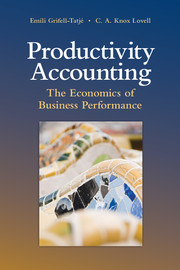Book contents
- Frontmatter
- Dedication
- Contents
- List of Tables
- List of Figures
- Preface
- 1 Introduction
- Part I Productivity and Profitability
- 2 Profitability Change
- 3 Decomposing the Productivity Change and Price Recovery Change Components of Profitability Change
- Part II Productivity and Profit
- Part III Productivity, Cost, and Return on Assets
- Bibliography
- Author Index
- Subject Index
3 - Decomposing the Productivity Change and Price Recovery Change Components of Profitability Change
Published online by Cambridge University Press: 05 January 2015
- Frontmatter
- Dedication
- Contents
- List of Tables
- List of Figures
- Preface
- 1 Introduction
- Part I Productivity and Profitability
- 2 Profitability Change
- 3 Decomposing the Productivity Change and Price Recovery Change Components of Profitability Change
- Part II Productivity and Profit
- Part III Productivity, Cost, and Return on Assets
- Bibliography
- Author Index
- Subject Index
Summary
Introduction
In Chapter 2 we decomposed change in business financial performance, as measured by profitability, into two components, the contributions of productivity change and price recovery change. In this chapter we extend the decomposition process by decomposing each component, but in different ways in order to satisfy different objectives. We want to attribute the productivity change component to economic drivers, so as to quantify the individual influences of management practices and technology on productivity change. We want to attribute the price recovery change component to individual variables, both to quantify the contributions of individual price changes to price recovery change and to explore the distribution of the financial impacts of productivity change.
We have three options for meeting these objectives. First, we can pair an empirical index of productivity change with an empirical index of price recovery change; we explore this option in Section 3.2. Second, we can pair a theoretical index of productivity change with a theoretical index of price recovery change; we explore this option in Section 3.3. Finally, we can pair a theoretical index of productivity change with an empirical index of price recovery change; we explore this option, with an empirical application, in Section 3.4. In Section 3.5 we summarize the analyses of Chapters 2 and 3 of profitability change, its drivers, and its distribution.
- Type
- Chapter
- Information
- Productivity AccountingThe Economics of Business Performance, pp. 112 - 156Publisher: Cambridge University PressPrint publication year: 2015



